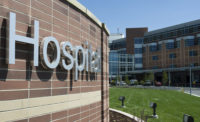ER workplace violence takes toll on health care workers

In a busy hospital emergency room, health care professionals administered Narcan to a patient suffering from a drug overdose. The measure revived him, but he was furious with them for interfering with his “high.” He grabbed one of the physicians, Dr. Leigh Vinocur, by the throat and began choking her - an assault that ended only when a radiology technician was able to get the man in a choke hold and subdue him. Vincour was left with bruises on her throat and broken blood vessels in her eyes.
The violence experienced by Vinocur, MD, FACEP, was, unfortunately, not an isolated incident. New research and polling data from the American College of Emergency Physicians (ACEP) – whose Emergency Department Violence Committee Vinocur has chaired – provides insights into how common emergency department violence is in U.S. hospitals and how it directly and indirectly affects patient care.
Hit and slapped
Some 72 percent of the 288 emergency department physicians who responded to the survey said they’d had violence perpetrated against them in past year, with a third of those sustaining injuries. Assaults – which were committed almost exclusively by patients - often took the form of being hit or slapped. Additionally, 96 percent of women, 80 percent of male physicians received inappropriate comments, touches or threats.
“We need to really work together and talk about this,” said Vinocur, who has served on the faculty at the University of Maryland School of Medicine in Baltimore and Louisiana State University Health Science Center, School of Medicine in Shreveport. “This study shows us that right here in the United States, these E.R. physicians who are on the front lines of taking care of people are getting caught in the cross hairs of violence.”
Vinocur describes the typical emergency department as being full of hurt, frightened and potentially volatile people – a microcosm of all of the challenges that we face today in society: fun violence, gang violence, people suffering from psychiatric illnesses and opioid addiction. (Like the man who assaulted her, approximately 50% of the assaults are committed by people under the influence of drugs, seeking drugs or withdrawing from drugs.)
Government Accountability Office (GAO) statistics show that workplace violence in healthcare is up to 12 times higher than any other type of employment in the United States.
“In some states and jurisdictions, it’s more dangerous working in an emergency department than being a police officer,” she said.
"Constanty fearful"
There’s a mental toll as well: the survey showed that 8.1 percent of respondents felt “constantly fearful” while at work.
In addition to the physical and mental trauma felt by health care personnel, violence in the emergency department affects patient care. Physicians may have to leave the area temporarily while order is restored, which increases wait time. They may also be distracted.
“This is a problem that it is real. It is increasing,” said Dr. Vidor Friedman, FACEP, president-elect of ACEP. Friedman shared his own story about being threatened by a drunken, hostile patient who’d just been released from prison after ten years of incarceration. When the man threatened the hospital staff “we appropriately restrained him, which only increased his agitation,” said Friedman, who noted that the fourth time the patient threatened him, “he said he was going to put an ice pick in my heart.”
The experience caused Friedman to avoid staying in his own home for days.
Hospitals reluctant to press charges
Friedman has so far been assaulted three times during his career, and each time his employer asked him to not press charges against his assailant. “I can’t think of another institution where that would happen,” he said.
The poll, in fact, found that only three percent of the hospitals where the respondents worked had pressed charges in cases where assaults had occurred. This, along with a tendency of health care workers to not report assaults, has masked the problem of emergency department violence.
The study’s author, Dr. Terry Kowalenko, FACEP, said physicians and nurses are three times more likely than workers in other industries to be victims of workplace violence. Kowalenko, who is chair of emergency medicine at Beaumont Hospitals in Michigan and serves as professor of emergency medicine at the Oakland University William Beaumont School of Medicine, said it’s not clear if assaults have increased or if more health care personnel are reporting it.
Education is key
Kowalenko said that in addition to changes in security, like additional guards, cameras and metal detectors, it’s important to educate health care workers about the problem.
“What do you do when a patient becomes violent?” he asked. “Well that’s already too late. We focus on recognizing the potentially violent patient and then defusing or de-escalating the situation.”
He added that policies contributing to a dangerous environment - such as the number of visitors allowed - must be clear and enforced. Laws mandating tougher penalties for assaults on health care employees would help, but they have a downside: there must be a victim in order for a law to be applied.
Kowalenko prefers prevention, but warns that employers must be on board: “It needs to be something that your institution takes seriously: to protect both the patients and the providers who work there.”
About ACEP
ACEP is the national medical specialty society representing emergency medicine. ACEP is committed to advancing emergency care through continuing education, research and public education. Headquartered in Dallas, Texas, ACEP has 53 chapters representing each state, as well as Puerto Rico and the District of Columbia. A Government Services Chapter represents emergency physicians employed by military branches and other government agencies.
Looking for a reprint of this article?
From high-res PDFs to custom plaques, order your copy today!









